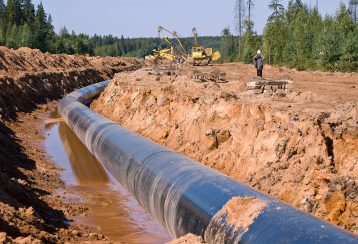Geocomposite Drains

Frequently Asked Questions
What is a Geocomposite?
A relatively thin sheet of two or more materials with a plastic drainage core that provides a high flow path for gas & liquids (usually ground water in Civil Engineering applications). The drainage core is bonded to a geotextile(s) to filter out soil particles and/or a geomembrane on the other side to provide a fluid barrier. Geocomposites are often specified as a value engineered and more sustainable alternative to traditional drainage aggregate.
What are usual applications for Drainage Geocomposites and what flow rate do I need?
In most civil engineering or building applications the flow rate of ground water is quite low and often referred to as seepage for example back of wall drainage to prevent water pressure building up and pushing on a structure. In the cases of ground water seepage nominal flow rates are required in the drainage Geocomposites. Specialist applications such as landfill cell capping or basal drainage may require higher flow rates, have higher confining pressures due to the weight of fill and lower hydraulic gradients. In these specialist applications the correct grade of Geocomposite drain is selected based upon the anticipated site conditions, the relevant British, European or International design standard should be followed.
What is the right Geocomposite grade to use?
The type of Geocomposite and the grade will depend upon the site conditions and the application. Generally, TERRAM B1, 1B1, 1BZ, 1C1 are used for back of wall vertical drainage applications with ground water seepage. A higher grade Geocomposite may be required when higher ground water flow rates, higher pressures (due to depth of soil fill layers) and lower hydraulic gradients (Geocomposite laid close to horizontal) are expected.
How do you install and join a Geocomposite?
TERRAM Geocomposites are manufactured in rolls varying from 2 to 4 wide and up to 100m long so are generally installed using mechanical lifting equipment for large areas, smaller rolls or sheets cut from larger rolls can be installed manually. When being used for back of wall drainage the Geocomposites can be held temporarily in place with a variety of fixings prior to backfilling with soil fill. For horizontal applications care must be taken to ensure the ground is flat or has a constant fall with no lumps or undulations to prevent ponding. All TERRAM Geocomposites are supplied with overlap edges which allow butt jointing and can be stapled or taped depending on the site conditions.
How long will Geocomposites last? (Design life)
When designed, installed and maintained in accordance with the published literature most TERRAM Geotextiles and Geocomposites are sufficiently durable to achieve a design life of at least 100 years in most typical soil conditions. Please refer to DoP (Declaration of Performance) certificates for specific product grades which state the anticipated design life based on independent durability testing.
What compressive loading will a Terram Geocomposite take?
All TERRAM Geocomposites have been tested with compressive loads between 20 and 200kPa to determine the flow rate capacity in accordance with EN ISO 12958. Flow rates at higher compressive loads are available on request.
How thick are the Geocomposites?
Between 4 and 10 mm depending on the grade of drainage net core, grade of geotextile or geomembrane. The thickness of the Geocomposite will decrease with increased weight of soil fill.
Original &
The Best







